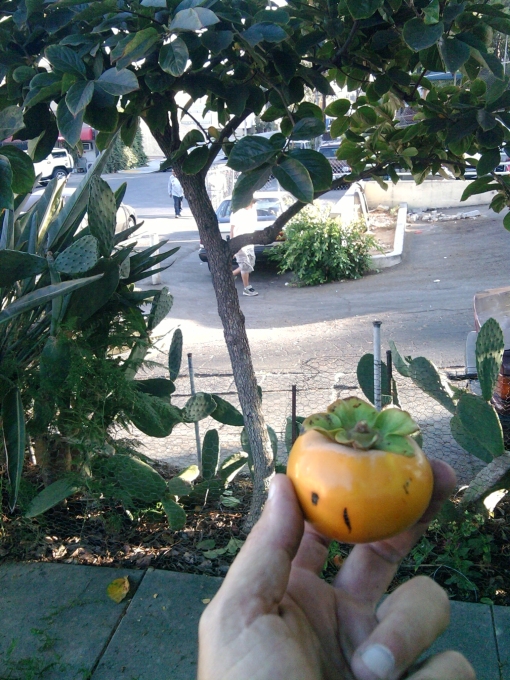
Persimmon fruit in my hand, persimmon tree in the background
We’ve got a persimmon tree which we don’t get a lot of fruit from. It’s not that our tree doesn’t yield, but between the squirrels, birds and passersby, I think I only had 2 or 3 persimmons from the tree last year.
Persimmons are orange-colored fruit, about the consistency of an apple, and very sweet and yummy. I thought that they were mosty from asia, but wikipedia tells me that there are various varieties from all over, including the Americas. The two varieties that I know of are very different. Our tree and my favorite kind of persimmon is the “Fuyu,” which seems to be the most accessible, easy to eat variety. Fuyus can be eaten like an apple. They’re firm and as they ripen they get softer, until they’re a little bit gooey. I love to cut them up and add to hot or cold cereal. There’s also Hachiya, which are said to be astringent. You can’t eat Hachiyas until they get really gooey. They tend to be good for baking into persimmon bread or cookies.
At least 15 years ago, eco-villagers planted a persimmon tree at the lot at the northeast corner of Bimini Place and White House Place. When the school district decided to tear down the house at that lot, about 2 years ago, we moved the tree to its current location along the alley at the south end of the Bimini Terrace. It’s now very visible to folks walking on the front sidewalk or down the alley. I think that plenty of the Korean halmonis recognize it as gam namu.
When squirrels nibble or birds peck at the fruit it looks like this (sorry blurry photo but you get the idea):

Learning to share our persimmons with other creatures
The fruit is mostly ripe right now, which seems slightly early – If I recall correctly, they generally ripen in November and December. Maybe it’s global warming or the hot dry summer or just natural variation.
Today I noticed that there were a lot of ants on the tree. At first I assumed that they were going to some of the fruit that looks like the photo above… but on closer inspection I saw that they were especially busy on one branch, which had a great deal of some sort of black lump creatures (which I think are called scale?) on it. Here’s a shot of that branch, which I immediately cut off:

Some kind of scale?
I scoured the tree and could only find a few more of these black lump creatures, mostly right next to ripe fruit. If anyone knows what these are called, and has any recommendations for keeping them under control (using non-toxic tools,) please post in the comments.
I know that ants were probably using tools long before humans were. Ants use aphids to get nutrition from other plants. Aphids are said to be very slow moving messy eaters, so ants help them get around, then eat their leftovers. Ants also harvest and spread molds and various other things that we human gardeners perceive as diseases when ants do their own harvesting of our cultivars. The ants have been really going to town this past summer… I will have to make sure they don’t do too much damage to the persimmon tree.